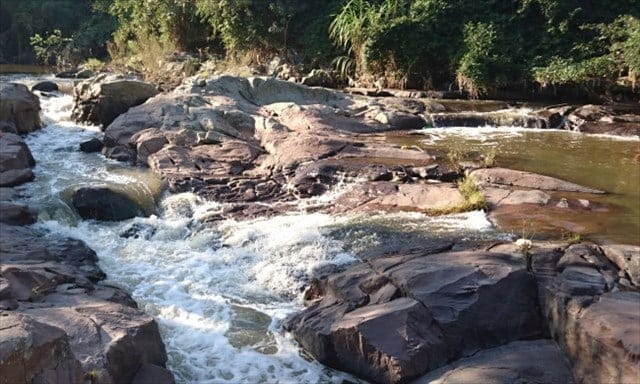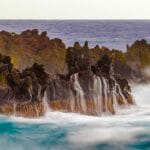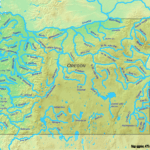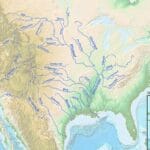Picture a rushing river, its waters crashing against rocks, slowly carving out the landscape. That’s hydraulic action in action! This natural phenomenon plays a key role in shaping our planet’s surface, from towering waterfalls to mighty canyons. Let’s dive into the thrilling world of hydraulic action and explore the fascinating power of flowing water.
Hydraulic Action: The Incredible Power of Water
Hydraulic action is the process by which the force of moving water breaks down and shapes rocks over time. Think of it as water’s own brand of super-strength used to sculpt the landscape around us.
This process begins when water, whether it’s a gentle stream or powerful ocean waves, forces its way into tiny cracks and crevices in the rock. This seemingly harmless water acts as a powerful wedge. As the water flows, it builds up pressure within these cracks, putting stress on the rock and gradually weakening its structure.
But water doesn’t stop there! In addition to wedging its way into cracks, flowing water carries sediment – tiny bits of rock and sand. This sediment acts like sandpaper, grinding against the riverbed or cliff face in a process called abrasion. Imagine constantly rubbing sandpaper on a piece of wood; eventually, it will wear down. That’s abrasion in action!
Together, hydraulic action and abrasion are a powerful duo capable of shaping entire landscapes. Ever seen a smooth, rounded pothole in a riverbed? That’s likely the work of hydraulic action and abrasion. Or how about those dramatic coastal cliffs that look like they’ve been sculpted by a giant artist? You guessed it – often the result of these powerful forces.
Scientists are still hard at work trying to fully understand all the nuances of hydraulic action. For example, the speed of the water, the type of rock, and even the shape of the riverbed can all play a role in how this process unfolds. It’s like a giant puzzle, and each piece helps us better understand the forces that have shaped our planet over millions of years.
What is Hydraulic Action (GCSE)?
Imagine a river flowing over rocks. That’s hydraulic action in action! It’s all about how the sheer force of water shapes and reshapes the earth’s surface.
Think of it like this: the water isn’t just flowing peacefully by; it’s got some real power behind it. As it rushes over the rocks, it’s strong enough to actually dislodge loose bits and pieces, such as pebbles, sand, even large chunks of rock if the water’s moving fast enough! The water then carries this debris along with it, kind of like a natural conveyor belt.
But there’s more to it than that. Water is sneaky and loves to find its way into every nook and cranny. When it flows over a rock surface, it forces air into any cracks or crevices it finds. Now, as the water keeps flowing, the trapped air gets squeezed and compressed, building up pressure inside the rock. It’s a bit like inflating a balloon until it bursts! Eventually, the pressure gets so intense that it can actually break the rock apart, making the crack even bigger. This process is what we call “air entrapment,” and it plays a huge role in how hydraulic action breaks down rocks.
And don’t forget the simple power of friction! The constant flow of water, especially if it’s carrying sand and pebbles, acts like sandpaper on the rock. It rubs and scrapes against the surface, slowly wearing it down over time. This process, known as “abrasion,” might not seem as dramatic as air entrapment, but trust me, it’s a powerful force in shaping landscapes over long periods.
So, why is all this important? Well, hydraulic action is like a master sculptor, shaping some of the most impressive landforms on Earth. Think towering canyons carved by raging rivers, dramatic sea cliffs sculpted by crashing waves, even the gradual formation of valleys over eons – it’s all thanks to hydraulic action.
But it’s not all about pretty scenery. Hydraulic action can also be a bit of a troublemaker. Did you know that erosion can be caused by elements of nature, including wind, water, and ice? Similarly, waves are one of the most common ways that coastlines are eroded. These erosional forces we talked about? They can cause serious problems like coastal erosion, where beaches are slowly eaten away by the relentless power of the waves. It’s a powerful reminder that while hydraulic action is a natural process, it can have a big impact on our lives.
Scientists are still hard at work, exploring the finer points of hydraulic action and how it interacts with other erosional forces. There’s still much to learn, but one thing’s for sure: this powerful force will continue to shape our planet for millions of years to come.
What are the 4 Types of Erosion?
We’ve already covered some ground on erosion, so let’s dive deeper into the four main ways it reshapes our world.
Think of these types of erosion like tools a sculptor uses—each one creates a different effect on the landscape.
1. Hydraulic Action: The Power of Water
Imagine the force of a firehose aimed at a sandcastle. That’s kind of what’s happening with hydraulic action. The sheer force of water, especially in rivers and oceans, can erode river banks and coastlines. It’s like a continuous battering ram, weakening the rock and eventually causing chunks to break off. This constant pounding is what carves out those impressive canyons and waterfalls we marvel at.
2. Abrasion: Nature’s Sandpaper
Here’s where things get a little more rough and tumble. As rivers flow, they carry with them a jumble of rocks, pebbles, and even sand. This moving debris acts like sandpaper, scraping and grinding against the riverbed and banks. Over time, this abrasion smooths out rough edges, much like sanding a piece of wood, and slowly but surely wears down the rock.
3. Attrition: Rocks vs. Rocks
It’s not just the riverbed that takes a beating. The rocks and pebbles carried by the water are constantly bumping and smashing into each other. It’s like a slow-motion demolition derby. This constant collision, called attrition, chips away at the rocks, breaking them down into smaller and smaller pieces. These fragments become the sand and sediment that flow along with the river.
4. Solution: Dissolving the Landscape
You know how sugar dissolves in water? Well, some rocks, like limestone, do the same thing, just much, much slower. When water flows over or seeps through these soluble rocks, it slowly dissolves them, creating cavities and weakening the structure. This process can lead to some fascinating formations like underground caves and sinkholes.
These four erosion processes, often working together, are constantly reshaping our planet. They’re why mountains become valleys, why rivers meander, and why coastlines change over time. Understanding these processes helps us appreciate the dynamic forces that have shaped, and continue to shape, the world around us.
What are the Effects of Hydraulic Action?
We’ve already talked a bit about what hydraulic action is – that incredible force of water shaping the earth around us. Now, let’s dive a little deeper and explore just how this “liquid sculptor” leaves its mark on the landscape.
Reshaping Landscapes: From Gentle Carving to Dramatic Collapses
Think of a river – a powerful current of water. Well, this current has the strength to wear away at the rocks and soil that form its bed and banks. This process, happening over time, can drastically change the river’s course, carving out valleys and gorges, essentially reshaping entire landscapes. Erosion can cause many different types of changes, both positive and negative.
Up high in the mountains, where rivers start their journey, the water plunges down with incredible force. This force, known as vertical erosion, is strong enough to chisel away at even the toughest bedrock. This is how we get those breathtakingly steep canyons, like the Grand Canyon, showcasing the sheer power of water over time.
As the river flows further downstream, it mellows out a bit, meandering across flatter land. Here, the erosive force shifts sideways, eating away at the riverbanks in a process called lateral erosion. This widens the river, sometimes creating those beautiful, winding curves we see in rivers.
The Hidden Power of Water Pressure
Now, hydraulic action isn’t always about brute force. Sometimes, it’s about the subtle, yet persistent pressure water can exert. Picture waves crashing against a cliff face. The sheer force is impressive, but what you might not see is the air trapped in the cracks and crevices of the rock.
As the waves pound the cliff, this trapped air compresses, putting immense pressure on the rock from within. Over time, this can weaken the cliff, leading to chunks breaking off and dramatic collapses. This process isn’t limited to coastlines either. It happens in rivers too, contributing to the widening of riverbeds and the creation of those awe-inspiring waterfalls we love to admire.
From Tiny Cracks to Major Fractures: The Role of Water in Rock Breakdown
We often think of erosion as a large-scale process, and it certainly can be. But hydraulic action also operates on a much smaller scale, slowly but surely breaking down rocks from the inside out.
How does this work? Well, water, even just a little bit of it, can seep into tiny cracks in rocks. As temperatures change, this water freezes and expands, acting like a tiny wedge that widens the crack a little bit more with each freeze-thaw cycle. Over time, this can cause significant damage, leading to rock falls and contributing to the overall shaping of the landscape.
A Never-Ending Story of Erosion and Change
Hydraulic action is a constant reminder of nature’s power to shape and reshape our world. It’s a process that’s been happening for millions of years, carving out canyons, widening rivers, and sculpting coastlines. So, the next time you see a rushing river or stand at the edge of a dramatic cliff, take a moment to appreciate the quiet power of water and the incredible impact it has on our planet.
What is the Hydraulic Effect?
We’ve already talked about how the earth’s surface changes over time, but have you ever stopped to think about the forces behind those changes? One of the most powerful forces is something we see every day: water. The hydraulic effect is all about the incredible erosive power of flowing water and its ability to literally reshape the planet.
Think about a rushing river or crashing waves. They don’t just flow peacefully, right? The force of that moving water creates pressure, and that pressure can have a big impact, especially on things like rock. Imagine water flowing over a rock surface. It pushes into every nook and cranny, and over time, it can actually widen existing cracks. Now, here’s where it gets interesting. Air often gets trapped in these cracks, and when the water pushes in, the air gets squeezed. This creates even more pressure – kind of like an invisible jackhammer! Eventually, all that pressure becomes too much for the rock to bear, and it starts to break down.
But water’s erosive power isn’t limited to brute force. It’s a bit of a multi-tasker, using a few different techniques to wear away at the earth:
Different Ways Water Erodes:
- Abrasion: Imagine sandpaper, but instead of paper, it’s water, and instead of sand, it’s carrying tiny bits of sediment and rock fragments. As this sediment-filled water flows over a surface, it acts like sandpaper, grinding away at the rock and wearing it down.
- Attrition: Picture rocks tumbling in a river or crashing against each other in the surf. That constant banging and scraping is attrition in action. The rocks are basically smashing into each other, breaking into smaller and smaller pieces over time.
- Solution: This one’s a bit sneakier. Some types of rock, like limestone, are susceptible to being dissolved by water. This process, called chemical weathering, can slowly eat away at the rock, changing its shape and structure over time.
The Impact of the Hydraulic Effect:
The hydraulic effect doesn’t just change the look of things – it has a profound impact on our planet.
- Landscape Sculpting: Ever been awestruck by the grandeur of the Grand Canyon or marveled at towering coastal cliffs? These dramatic features, and countless others, are the result of the hydraulic effect tirelessly working over millions of years. Rivers and waves, wielding the power of erosion, have sculpted some of the most breathtaking landscapes on Earth.
- Coastal Erosion: While beautiful, the hydraulic effect can also be a powerful force of change along coastlines. It can lead to dramatic cliff collapses, reshape beaches, and even threaten infrastructure built too close to the water’s edge.
- Habitat Loss: As coastal areas erode, important habitats for marine life can be lost or altered. This can disrupt ecosystems and impact the delicate balance of life along our coasts.
While we understand the basics of the hydraulic effect, there’s still much that researchers are actively studying. For example, how do specific climate changes influence the rate of erosion? How can we better predict and mitigate the impacts of hydraulic erosion on coastal communities? These are just a couple of the questions scientists are working to answer.
One thing is certain: the hydraulic effect is a constant reminder of the immense power of nature and its ability to shape the world around us.
What Do You Mean by Hydraulic Action?
So, we’ve been talking about how water shapes the land, right? Well, one of the big players in this whole erosion game is something called “hydraulic action.” Sounds complicated, but it’s actually pretty straightforward.
Think about a time you’ve seen a fast-flowing river or maybe even just a strong jet of water from a hose. That water has a surprising amount of power behind it. Now, imagine that force hitting against a rock face, especially one with little cracks and crevices.
Here’s what happens: The water jams into those cracks and gets trapped for a split second. This creates a mini-explosion of pressure within the rock. It’s like constantly flicking your finger against a piece of paper – eventually, it’s going to start to weaken and tear.
That’s essentially what hydraulic action does! The relentless pounding of the water, combined with these tiny pressure bursts, gradually breaks down the rock. Over time, small cracks become bigger ones, chunks break off, and the landscape begins to change.
Now, this doesn’t happen overnight. We’re talking about a slow and steady process that can take hundreds, thousands, even millions of years to create dramatic effects. But the evidence is all around us! Think about the Grand Canyon, for example. That awe-inspiring natural wonder? Yeah, that’s largely the work of hydraulic action, with the Colorado River tirelessly chipping away at the rock for eons.
And it’s not just canyons. Hydraulic action plays a role in shaping coastlines, carving out caves, and even influencing the way rivers meander across the land.
Here’s the gist:
- Hydraulic action = erosion by water power, plain and simple.
- Water forces its way into cracks, builds up pressure, and boom – the rock weakens.
- This happens everywhere water flows with any force – rivers, coastlines, you name it.
- While it’s a gradual process, the long-term effects of hydraulic action on our planet’s landscape are undeniable.
Want to learn more? This is just scratching the surface! There’s a whole lot more to discover about erosion and the forces shaping our world. Check out resources from organizations like National Geographic or the U.S. Geological Survey to dive deeper.
What is a Hydraulic Explanation?
So, we’ve been talking about how water shapes the earth, right? Well, hydraulic action is a big part of that. It’s basically the sheer force of moving water acting like a battering ram against the ground and the sides of rivers and coastlines. Think of it like this: imagine a fire hose turned on full blast – that powerful jet of water can knock you over, right? Now imagine that same force hitting rocks, soil, and sediment over time. You get the picture!
What happens is, this relentless water flow isn’t just gliding over the surface. It’s actively seeking out any weakness it can find – cracks, holes, even tiny spaces between grains of sand. As the water surges into these openings, it often traps air inside. This trapped air creates pressure, and it’s that pressure that starts to do some real damage.
It’s kind of like when you use a wedge to split wood. You hammer the wedge into a crack, and the force spreads outward, eventually forcing the wood apart. In this case, the water is like the wedge, and the pressure it creates weakens the rock or sediment, making it more likely to break apart.
Over time, this constant pounding, combined with the pressure from trapped air, chips away at the surrounding material. It’s a slow and gradual process, kind of like using sandpaper on wood, but eventually, it can carve out impressive features: think canyons, gorges, and even those dramatic coastal cliffs you see in pictures.
Now, scientists are always refining our understanding of these natural processes, and it seems like there’s still some debate about just how significant hydraulic action is compared to other forces of erosion. Some experts believe it plays a primary role, while others suggest it might be more of a supporting actor, working in conjunction with things like abrasion (where particles carried by the water act like sandpaper) and chemical weathering (where the water itself dissolves the rock).
Regardless of the exact role it plays, one thing’s for sure: hydraulic action is a powerful reminder that water, despite its seemingly gentle nature, is a force to be reckoned with. It constantly shapes and reshapes our planet, carving out landscapes that inspire awe and wonder.
What is Hydraulic Action in a Waterfall?
We’ve been talking about how waterfalls sculpt the landscape, right? Well, hydraulic action is one of the big players in that process. It’s basically the sheer force of moving water wearing away at the rock.
Imagine this: a waterfall crashing down from a height. That water isn’t just falling gracefully; it’s slamming onto the rocks below with immense power. This impact creates a lot of pressure. Now, rocks aren’t perfectly smooth; they have cracks and crevices. As the water pounds down, it forces air into these spaces, trapping it. This trapped air acts like tiny little explosions, pushing against the rock from the inside and weakening it further.
Think about it like constantly hitting a wall with a hammer. Over time, even the strongest wall will start to crumble. That’s what hydraulic action does to the rocks at the base of a waterfall.
And here’s the thing: the taller the waterfall, the more powerful the force of the water. It’s like comparing a gentle stream to a fire hose – the force is just on another level. That’s why you often see deep pools (called plunge pools) at the bottom of waterfalls. They’re literally carved out by the relentless force of the water.
But it doesn’t stop there! Hydraulic action doesn’t just carve out plunge pools. It also creates all sorts of interesting formations on the rock face. You know those smooth, swirling depressions you sometimes see? Those are called potholes, and they’re formed by the water spinning around and around, like a drill bit. And then there are channels, which are basically grooves etched into the rock by the flow of water.
The amazing thing is that this is an ongoing process. Waterfalls are constantly evolving, even if we can’t see it happening in real-time. Every drop of water that flows over that edge contributes to the ongoing transformation of the landscape. It’s a powerful reminder that nature is always at work, shaping and reshaping the world around us.
What are Hydraulic Action and Solution?
So, we’ve been talking about how rivers and coastlines change over time. Well, hydraulic action and solution are two big players in that game! They both involve water interacting with rock, but in slightly different ways.
Think of a fast-flowing river. As the water rushes over rocks, it’s not just gliding by—it’s actually pushing against the rock’s surface with a surprising amount of force. This pressure can work its way into tiny cracks and crevices in the rock. Over time, it’s like constantly pushing on the same spot on a piece of cardboard—eventually, it’s going to weaken and break. That’s hydraulic action in a nutshell: the force of the water itself breaking down the rock.
But water doesn’t always need to be forceful to make a change. Sometimes it’s more like a sneaky magician, dissolving rock away bit by bit. This process is called solution. Certain types of rock, like limestone, are particularly vulnerable to this. They contain minerals that can dissolve in water, especially slightly acidic water. Think of how sugar dissolves in your tea or coffee—similar idea! As the water seeps through the rock, it slowly carries away these dissolved minerals, which can over time create some pretty amazing features like caves and sinkholes.
Now, let’s break down hydraulic action a bit further, as it’s not always just the direct force of the water. It often gets help from some tiny accomplices:
1. Abrasion: Imagine the water carrying tiny bits of sand and gravel. As the water slams these particles against the rock, it’s like sandpaper wearing down a piece of wood. This constant scraping and grinding away is called abrasion.
2. Attrition: And what happens to those bits of sand and gravel as they are being carried along by the water? They’re bumping into each other! This constant collision causes them to break down into even smaller pieces, making them even more effective at eroding the surrounding rock.
So, to recap:
- Hydraulic Action: Imagine this as the brute force of the water, pushing and wedging its way into cracks.
- Solution: This is the stealthy approach, where water dissolves certain minerals within the rock.
- Abrasion: Think of this as the sandpaper effect, with sediment carried by the water wearing away at the rock.
- Attrition: This is about the sediment itself breaking down into smaller pieces, increasing its erosive power.
These processes, working together over long periods, are what shape our canyons, carve out coastlines and sculpt some of the most stunning natural features on earth. The next time you see a rushing river or a dramatic coastline, take a moment to appreciate the power of water and these incredible processes at work!
It’s important to remember that our understanding of these processes is always evolving as scientists make new discoveries. While we have a good grasp of the basics, there’s still much to learn about the intricate details of how hydraulic action and solution shape our planet.
What is Hydraulic Action in the Desert?
We often think of deserts as dry, still places, right? But what if I told you that even in these seemingly quiet landscapes, water is secretly sculpting and carving out amazing formations? Intrigued? Let’s dig into how this happens through a process called hydraulic action.
You know how water has this incredible force? Think about the power of a rushing river. Well, that force is what drives hydraulic action. It’s all about the impact of flowing water hitting and wearing away at rock surfaces.
Now, you might be thinking, “Hold on, deserts are all about sand and barely any water!” And you’d be right to some extent. But here’s the thing: Deserts do get rain, sometimes even sudden downpours. And while it might not stick around like in other places, that water has enough power to cause some serious erosion.
Plus, there’s another sneaky source of water in the desert: wind! Okay, not actual liquid water, but wind carries tiny sand particles. These particles, believe it or not, can act like miniature chisels, wearing away at rock just like water does.
So, how does this play out in the desert? Well, imagine a sudden desert storm. Rain pours down, creating temporary rivers and streams that surge through canyons and valleys. This rushing water, packed with the force of the storm, slams against the rock walls. Over time, this constant battering can carve out those dramatic, steep-sided canyons we often associate with deserts.
But it’s not just about sudden storms. Even the slow, steady trickle of water over centuries can have a huge impact. Think of mesas, those flat-topped mountains rising out of the desert floor. They were likely once part of a larger plateau, slowly whittled down by the persistent power of hydraulic action.
And it doesn’t stop there. Hydraulic action is a bit of a master artist in the desert, sculpting all sorts of incredible formations. From waterfalls cascading over rocky outcrops to those mysterious potholes you might stumble across, the fingerprints of hydraulic action are everywhere in the desert landscape.
Scientists are still unraveling all the mysteries of how water shapes the desert. They’re exploring questions like: How much of a role does the type of rock play in how quickly it erodes? And how do subtle changes in wind patterns over decades affect these processes?
So, the next time you picture a desert, don’t just see a barren wasteland. Imagine the unseen forces of water, patiently chipping away at rock, crafting a landscape of stark beauty and hidden wonders.
What is Hydraulic Action (KS2)?
So, we’ve been talking about how rivers and oceans can change the way our planet looks, right? Well, one of the big ways they do that is through something called “hydraulic action.” It’s a pretty cool name for what’s basically water flexing its muscles!
Imagine a powerful wave crashing against a cliff or a fast-flowing river slamming into the rocks in its path. That force, that energy from the moving water, is strong enough to cause serious damage over time. Think of it like using a hammer on a rock – eventually, it’s going to start to crack and break apart.
Now, you might be thinking, “How can water be as strong as a hammer?” Well, it’s not just about the water itself, but also what happens when it gets into those tiny cracks and crevices in the rock. It acts like a wedge, pushing air into the cracks and creating pressure. This constant pushing and shoving weakens the rock from the inside out, making it more likely to crumble and break away.
Hydraulic action is a slow and steady process, but it’s happening all the time! It’s the reason rivers meander and twist, carving out valleys and canyons over millions of years. It’s why we see dramatic sea cliffs and arches – the constant pounding of waves slowly chipping away at the coastline.
Scientists are still studying exactly how hydraulic action works in different environments, and they’re finding that things like the type of rock and the speed of the water can play a big role. But one thing’s for sure: hydraulic action is a powerful force of nature that helps to shape the world around us!
Key Points of Hydraulic Action:
- The force of moving water can break down and shape rocks over time.
- Water enters tiny cracks and crevices in rocks, creating a wedge effect.
- The flowing water builds up pressure within the cracks, weakening the rock.
- Sediment carried by the water acts as sandpaper, grinding against the rock through abrasion.
- Hydraulic action and abrasion work together to shape landscapes, creating features like potholes and coastal cliffs.
- The speed of the water, the type of rock, and the shape of the riverbed influence the process.
- Scientists continue to study hydraulic action to better understand its role in shaping Earth’s landscapes.
- Unlocking Francis Alexander Shields’ Finance Empire: A Comprehensive Biography - July 12, 2025
- Unveiling Francis Alexander Shields: A Business Legacy - July 12, 2025
- Francis Alexander Shields’ Business Career: A Comprehensive Overview - July 12, 2025















